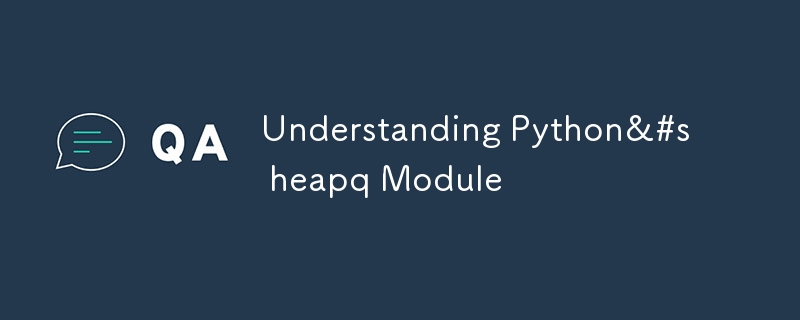
在 Python 中,堆是一個強大的工具,可以有效地管理元素集合,在這些元素集合中,您經常需要快速訪問最小(或最大)的項目。
Python中的heapq模組提供了堆隊列演算法的實現,也稱為優先權佇列演算法。
本指南將解釋堆的基礎知識以及如何使用 heapq 模組,並提供一些實際範例。
堆是一種特殊的基於樹的資料結構,滿足堆屬性:
在 Python 中,heapq 實作了最小堆,這意味著最小的元素始終位於堆的根部。
當您需要時,堆特別有用:
heapq 模組提供了對常規 Python 清單執行堆操作的函數。
使用方法如下:
要建立堆,請從一個空列表開始,然後使用 heapq.heappush() 函數新增元素:
import heapq heap = [] heapq.heappush(heap, 10) heapq.heappush(heap, 5) heapq.heappush(heap, 20)
經過這些操作,堆將是 [5, 10, 20],最小元素位於索引 0。
只需引用heap[0]即可存取最小元素,而無需刪除它:
smallest = heap[0] print(smallest) # Output: 5
要刪除並傳回最小元素,請使用 heapq.heappop():
smallest = heapq.heappop(heap) print(smallest) # Output: 5 print(heap) # Output: [10, 20]
此操作後,堆會自動調整,下一個最小的元素佔據根位置。
如果你已經有一個元素列表,可以使用 heapq.heapify() 將其轉換為堆:
numbers = [20, 1, 5, 12, 9] heapq.heapify(numbers) print(numbers) # Output: [1, 9, 5, 20, 12]
堆化後,數字將為[1, 9, 5, 12, 20],保持堆屬性。
heapq.merge() 函數可讓您將多個排序輸入合併為一個排序輸出:
heap1 = [1, 3, 5] heap2 = [2, 4, 6] merged = list(heapq.merge(heap1, heap2)) print(merged) # Output: [1, 2, 3, 4, 5, 6]
這會產生 [1, 2, 3, 4, 5, 6]。
您也可以使用 heapq.nlargest() 和 heapq.nsmallest() 來找出資料集中最大或最小的 n 個元素:
numbers = [20, 1, 5, 12, 9] largest_three = heapq.nlargest(3, numbers) smallest_three = heapq.nsmallest(3, numbers) print(largest_three) # Output: [20, 12, 9] print(smallest_three) # Output: [1, 5, 9]
最大的_三將是[20,12,9],最小的_三將是[1,5,9]。
堆的一個常見用例是實現優先權隊列,其中每個元素都有優先權,並且首先服務具有最高優先權(最低值)的元素。
import heapq
class PriorityQueue:
def __init__(self):
self._queue = []
self._index = 0
def push(self, item, priority):
heapq.heappush(self._queue, (priority, self._index, item))
self._index += 1
def pop(self):
return heapq.heappop(self._queue)[-1]
# Usage
pq = PriorityQueue()
pq.push('task1', 1)
pq.push('task2', 4)
pq.push('task3', 3)
print(pq.pop()) # Outputs 'task1'
print(pq.pop()) # Outputs 'task3'
在此範例中,任務以其各自的優先權儲存在優先權佇列中。
優先權值最低的任務總是先彈出。
Python 中的 heapq 模組是一個強大的工具,用於有效管理需要維護基於優先順序的排序順序的資料。
無論您是建立優先權佇列、尋找最小或最大元素,還是只需要快速存取最小元素,堆都提供了靈活高效的解決方案。
透過了解和使用 heapq 模組,您可以編寫更有效率、更簡潔的 Python 程式碼,尤其是在涉及即時資料處理、排程任務或管理資源的場景中。
以上是了解Python的heapq模組的詳細內容。更多資訊請關注PHP中文網其他相關文章!




